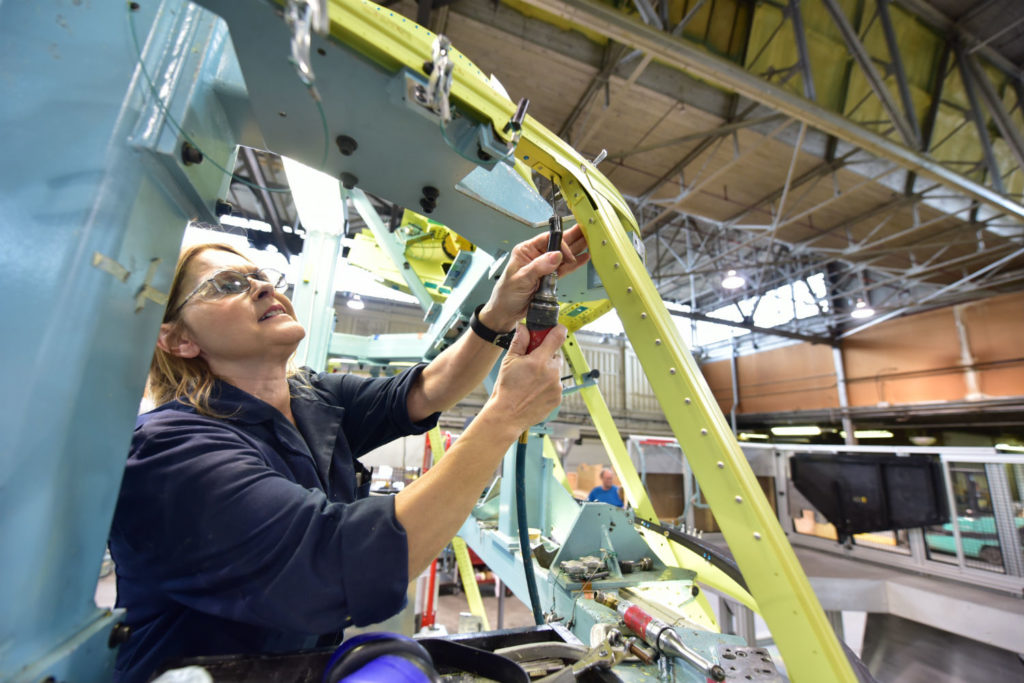Estimated reading time 7 minutes, seconds.
A new study from the Canadian Council for Aviation & Aerospace (CCAA) confirms and quantifies what most in the industry have known for years: A significant labour shortage is on the horizon, and a cohesive mitigation strategy is needed.

The study, released April 20, 2018, indicates a need to hire 55,000 new workers by 2025 to keep pace with projected industry growth, and to replace workers who are retiring or leaving the workforce for other reasons.
This represents one third of the existing workforce of 154,000 today, a daunting challenge for the industry.
“Due to the skilled labour shortage, companies otherwise well positioned for growth are unable to plan for development that the market is actually calling for,” said Leslie Hogan, CCAA project manager, in an interview with Skies. “It is stifling potential for the economy to grow.”
While Boeing and CAE have both released projections for the global pilot shortage, the CCAA study focuses exclusively on the Canadian market, and the various subsectors of the industry.
The report projects Canada will need an additional 7,300 pilots and an additional 5,300 new aircraft mechanics by 2025. It quantifies hiring needs for a range of other professions such as avionics, air traffic control, machinists, and managers.
It also looks at “skills shortages,” a term that refers to additional skills needed by graduates or the existing workforce in response to new technologies and business needs.
“To address these issues and to ensure that the aviation and aerospace industry in Canada continues to thrive, a multi-faceted national strategy is required,” the study notes.

“Absent such a strategy, we see growth coalescing around larger companies in the short term, at the expense of small and medium size businesses. In the longer term if we do not have sufficient workers with the right skills, the entire industry will suffer.”
The study also looks at labour supply–the current and projected number of graduates from Canadian college and university programs.
Only a quarter of the needed workers–about 14,000–will be domestic graduates. Industry must find 41,000 additional workers from other industries, and from outside Canada.
According to the study, most developed nations have similar, or even greater projected shortages of qualified workers.
“Just as Canada may look overseas to meet the needs of its labour shortages, other countries seek to attract Canadian talent to address their own shortfalls,” the study notes.
“With many other industries also experiencing labour shortages, we are all competing for graduates”.
CCAA has been conducting labour market information (LMI) studies for many years. Data collection is seen as a diagnostic tool that will help CCAA and its partners develop concrete solutions. This most recent study was conducted over a span of four years.

“Everything we do at CCAA starts with labour market information and we will continue to conduct such studies in order to provide industry, educators and government, with the data necessary to make informed decisions.” said Theresa Davis-Woodhouse, director of project management and accreditation for the CCAA.
The CCAA labour market report provides data the organization hopes will enable industry to develop a comprehensive national labour market strategy.
With industry support, CCAA said it is coordinating the work, “because it’s hard for any one company or region to do on its own.”
Appealing to young Canadians is a key part of the national strategy, along with recruiting under-represented groups such as women and indigenous peoples.
Women make up only 30 per cent of aviation and aerospace workers, and indigenous peoples make up only three per cent, according to the study. Only seven per cent of pilots and six per cent of mechanics in Canada are female.
“We need outreach programs to make students aware of the exciting career paths that are available in our industry, and to make sure they understand what courses they need to take for the wide variety of careers available,” said Davis-Woodhouse.
Education also plays a critical role in the national strategy, creating new ways of learning and ensuring what is being taught reflects industry needs.

The federal government selected the CCAA to lead a student work integrated learning program (SWILP) for the aviation and aerospace industry. The program provides wage subsidies to employers who hire students in order to provide them with hands-on training.
CCAA is also working with a consortium of companies and colleges to develop a program that will combine the skills of maintenance technicians with those of avionics technicians and interior technicians, as well as business skills and soft skills.
The program will deliver “multi-disciplinary technicians” to meet a demand for workers with broader skill sets.
“We’ve had really great support from industry for this work, and industry has asked for similar programs combining other trades,” said Davis-Woodhouse
“On behalf of the industry, we wish to acknowledge and thank the federal government for funding this study through the Sector Initiatives Program,” said Robert Donald, executive director of the CCAA.
“Without their support, the study would not have been possible.”








